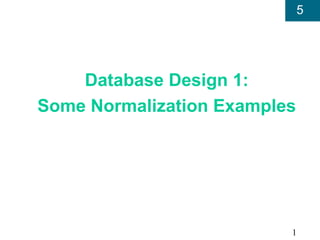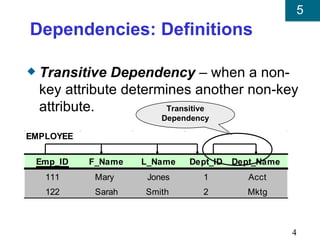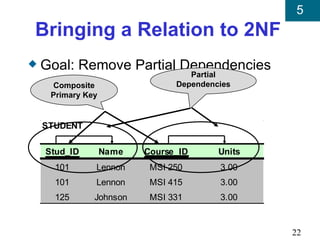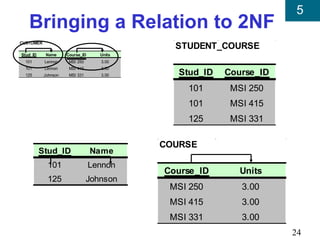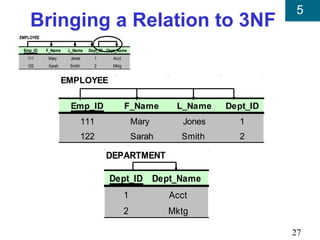Normalization
- 1. 5 Database Design 1: Some Normalization Examples 1
- 2. 5 Dependencies: Definitions x Multivalued Attributes (or repeating groups): non- key attributes or groups of non-key attributes the values of which are not uniquely identified by (directly or indirectly) (not functionally dependent on) the value of the Primary Key (or its part). STUDENT Stud_ID Name Course_ID Units 101 Lennon MSI 250 3.00 101 Lennon MSI 415 3.00 125 Johnson MSI 331 3.00 2
- 3. 5 Dependencies: Definitions x Partial Dependency – when an non-key attribute is determined by a part, but not the whole, of a COMPOSITE primary key. Partial CUSTOMER Dependency Cust_ID Name Order_ID 101 AT&T 1234 101 AT&T 156 125 Cisco 1250 3
- 4. 5 Dependencies: Definitions x Transitive Dependency – when a non- key attribute determines another non-key attribute. Transitive Dependency EMPLOYEE Emp_ID F_Name L_Name Dept_ID Dept_Name 111 Mary Jones 1 Acct 122 Sarah Smith 2 Mktg 4
- 5. 5 Normal Forms: Review x Unnormalized – There are multivalued attributes or repeating groups x 1 NF – No multivalued attributes or repeating groups. x 2 NF – 1 NF plus no partial dependencies x 3 NF – 2 NF plus no transitive dependencies 5
- 6. 5 Example 1: Determine NF All attributes are directly x ISBN  Title or indirectly determined x ISBN  Publisher by the primary key; therefore, the relation is x Publisher  Address at least in 1 NF BOOK ISBN Title Publisher Address 6
- 7. 5 Example 1: Determine NF The relation is at least in 1NF. x ISBN  Title There is no COMPOSITE x ISBN  Publisher primary key, therefore there can’t be partial dependencies. x Publisher  Address Therefore, the relation is at least in 2NF BOOK ISBN Title Publisher Address 7
- 8. 5 Example 1: Determine NF Publisher is a non-key attribute, x ISBN  Title and it determines Address, x ISBN  Publisher another non-key attribute. Therefore, there is a transitive x Publisher  Address dependency, which means that the relation is NOT in 3 NF. BOOK ISBN Title Publisher Address 8
- 9. 5 Example 1: Determine NF We know that the relation is at x ISBN  Title least in 2NF, and it is not in 3 x ISBN  Publisher NF. Therefore, we conclude that the relation is in 2NF. x Publisher  Address BOOK ISBN Title Publisher Address 9
- 10. 5 Example 1: Determine NF x ISBN  Title In your solution you will write the following justification: x ISBN  Publisher • No M/V attributes, therefore at x Publisher  least 1NF • No partial dependencies, Address therefore at least 2NF • There is a transitive dependency (Publisher  Address), therefore, not 3NF Conclusion: The relation is in 2NF BOOK ISBN Title Publisher Address 10
- 11. 5 Example 2: Determine NF x Product_ID  Description All attributes are directly or indirectly determined by the primary key; therefore, the relation is at least in 1 NF ORDER Order_No Product_ID Description 11
- 12. 5 Example 2: Determine NF x Product_ID  Description The relation is at least in 1NF. There is a COMPOSITE Primary Key (PK) (Order_No, Product_ID), therefore there can be partial dependencies. Product_ID, which is a part of PK, determines Description; hence, there is a partial dependency. Therefore, the relation is not 2NF. No sense to check for transitive dependencies! ORDER Order_No Product_ID Description 12
- 13. 5 Example 2: Determine NF x Product_ID  Description We know that the relation is at least in 1NF, and it is not in 2 NF. Therefore, we conclude that the relation is in 1 NF. ORDER Order_No Product_ID Description 13
- 14. 5 Example 2: Determine NF x Product_ID  Description In your solution you will write the following justification: 1) No M/V attributes, therefore at least 1NF 2) There is a partial dependency (Product_ID  Description), therefore not in 2NF Conclusion: The relation is in 1NF ORDER Order_No Product_ID Description 14
- 15. 5 Example 3: Determine NF x Part_ID  Description Comp_ID and No are not x Part_ID  Price determined by the primary key; therefore, the relation x Part_ID, Comp_ID  No is NOT in 1 NF. No sense in looking at partial or transitive dependencies. PART Part_ID Descr Price Comp_ID No 15
- 16. 5 Example 3: Determine NF In your solution you will write x Part_ID  Description the following justification: 2) There are M/V attributes; x Part_ID  Price therefore, not 1NF x Part_ID, Comp_ID  No Conclusion: The relation is not normalized. PART Part_ID Descr Price Comp_ID No 16
- 17. 5 Bringing a Relation to 1NF STUDENT Stud_ID Name Course_ID Units 101 Lennon MSI 250 3.00 101 Lennon MSI 415 3.00 125 Johnson MSI 331 3.00 17
- 18. 5 Bringing a Relation to 1NF x Option 1: Make a determinant of the repeating group (or the multivalued attribute) a part of the primary key. Composite Primary Key STUDENT Stud_ID Name Course_ID Units 101 Lennon MSI 250 3.00 101 Lennon MSI 415 3.00 125 Johnson MSI 331 3.00 18
- 19. 5 Bringing a Relation to 1NF x Option 2: Remove the entire repeating group from the relation. Create another relation which would contain all the attributes of the repeating group, plus the primary key from the first relation. In this new relation, the primary key from the original relation and the determinant of the repeating group will comprise a primary key. STUDENT Stud_ID Name Course_ID Units 101 Lennon MSI 250 3.00 101 Lennon MSI 415 3.00 125 Johnson MSI 331 3.00 19
- 20. 5 Bringing a Relation to 1NF STUDENT Stud_ID Name 101 Lennon 125 Jonson STUDENT_COURSE Stud_ID Course Units 101 MSI 250 3 101 MSI 415 3 125 MSI 331 3 20
- 21. 5 Bringing a Relation to 2NF Composite Primary Key STUDENT Stud_ID Name Course_ID Units 101 Lennon MSI 250 3.00 101 Lennon MSI 415 3.00 125 Johnson MSI 331 3.00 21
- 22. 5 Bringing a Relation to 2NF x Goal: Remove Partial Dependencies Partial Composite Dependencies Primary Key STUDENT Stud_ID Name Course_ID Units 101 Lennon MSI 250 3.00 101 Lennon MSI 415 3.00 125 Johnson MSI 331 3.00 22
- 23. 5 Bringing a Relation to 2NF x Remove attributes that are dependent from the part but not the whole of the primary key from the original relation. For each partial dependency, create a new relation, with the corresponding part of the primary key from the original as the primary key. STUDENT Stud_ID Name Course_ID Units 101 Lennon MSI 250 3.00 101 Lennon MSI 415 3.00 125 Johnson MSI 331 3.00 23
- 24. 5 Bringing a Relation to 2NF CUSTOMER STUDENT_COURSE Stud_ID Name Course_ID Units 101 Lennon MSI 250 3.00 101 Lennon MSI 415 3.00 125 Johnson MSI 331 3.00 Stud_ID Course_ID 101 MSI 250 101 MSI 415 125 MSI 331 COURSE Stud_ID Name 101 Lennon Course_ID Units 125 Johnson MSI 250 3.00 MSI 415 3.00 MSI 331 3.00 24
- 25. 5 Bringing a Relation to 3NF x Goal: Get rid of transitive dependencies. Transitive Dependency EMPLOYEE Emp_ID F_Name L_Name Dept_ID Dept_Name 111 Mary Jones 1 Acct 122 Sarah Smith 2 Mktg 25
- 26. 5 Bringing a Relation to 3NF x Remove the attributes, which are dependent on a non-key attribute, from the original relation. For each transitive dependency, create a new relation with the non-key attribute which is a determinant in the transitive dependency as a primary key, and the dependent non-key attribute as a dependent. EMPLOYEE Emp_ID F_Name L_Name Dept_ID Dept_Name 111 Mary Jones 1 Acct 122 Sarah Smith 2 Mktg 26
- 27. 5 Bringing a Relation to 3NF EMPLOYEE Emp_ID F_Name L_Name Dept_ID Dept_Name 111 Mary Jones 1 Acct 122 Sarah Smith 2 Mktg EMPLOYEE Emp_ID F_Name L_Name Dept_ID 111 Mary Jones 1 122 Sarah Smith 2 DEPARTMENT Dept_ID Dept_Name 1 Acct 2 Mktg 27

